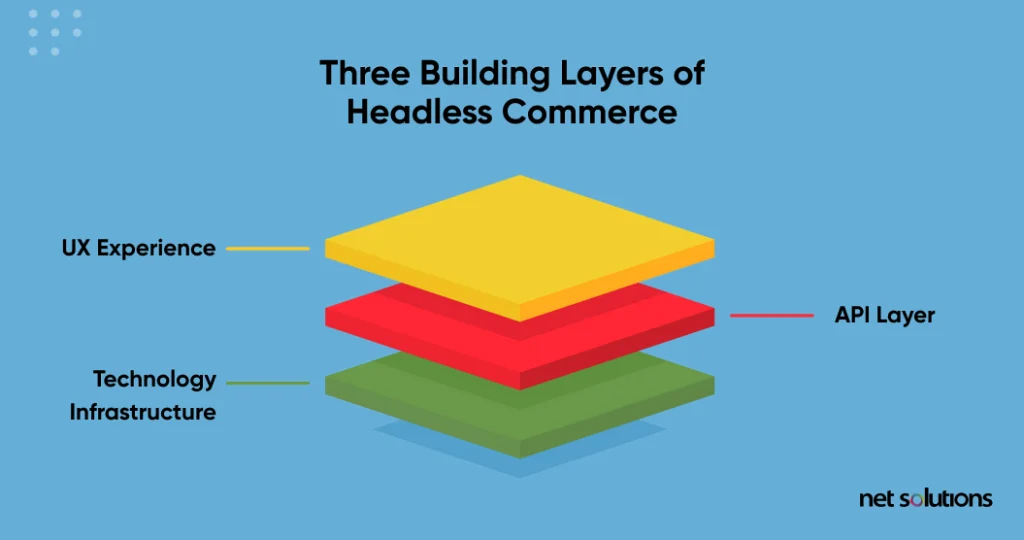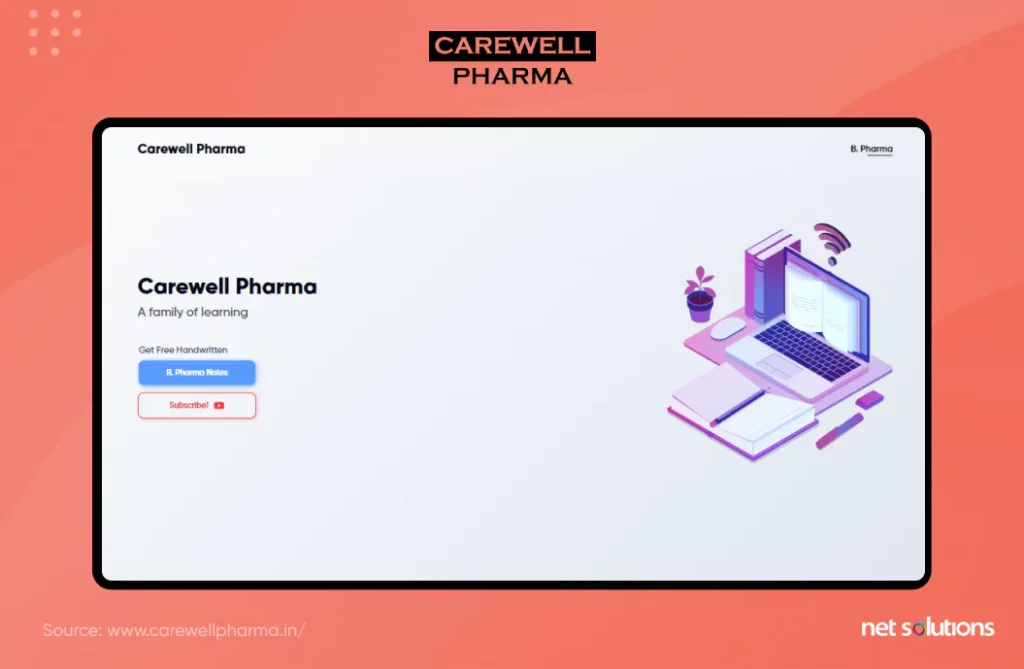Across the world, eCommerce business owners and web developers know the importance of choosing the best eCommerce platform and turning to headless commerce, and specifically BigCommerce, to deliver optimized, personalized omnichannel experiences to any device or channel. BigCommerce is a headless commerce platform that helps customers at every stage of growth to build, innovate and grow their online business (B2C or B2B).
The guide will help you understand the benefits of using the customizable, scalable, high-performance BigCommerce platform to better serve your customers and achieve the flexibility you need to grow your business, including:
- The features and advantages of using BigCommerce
- The disadvantages of BigCommerce, to give you an unbiased review
- How to go headless with BigCommerce
- Who should go headless with BigCommerce
- Examples of BigCommerce in action
Disclaimer: The information below is accurate as of June 26, 2024.
What Is Headless Commerce?
A traditional eCommerce platform is “monolithic,” the storefront, data and backend all being stored together. This is very fast to manage and launch, but with downsides across customization, personalization across channels, and performance.
A headless commerce platform is decoupled, separating the front end (the storefront your users see and interact with / the user experience or UK) from the back end (the infrastructure and data), leveraging APIs to communicate between the front and back.

What is BigCommerce?
BigCommerce is a software-as-a-service (What is SaaS) headless eCommerce platform that offers full enterprise capabilities, omnichannel selling, B2B capabilities (everything you need to know about B2B), and composable commerce. BigCommerce includes hosting, updates, security and compliance, with enterprise-level capabilities built into the platform and supported by integrations. There are zero additional transaction fees or penalties, making it attractive as a commerce solution.
Founded in 2009 by Australians Eddie Machaalani and Mitchell Harper, BigCommerce went public in 2020 and now supports tens of thousands of merchants to sell billions of dollars in products and services across 150+ countries. BigCommerce was named a 2023 Gartner “challenger” in digital commerce and a 2024 “leader” by IDC and is trusted by global retailers, including Badgley Mischka, Samsung, Dell, Ballad Industrial, Houzer, and Yeti Cycles.
Features of Headless BigCommerce
BigCommerce stands out ahead of competition in the headless commerce space, including against Shopify and Magento, due to its advanced business features and customizability, including:
1. Integrate with your existing website or app
BigCommerce is headless, allowing you to quickly integrate with your front-end website or app, letting BigCommerce handle the back-end store components such as catalog management, processing payments, or managing fulfillment logistics.
BigCommerce supports a variety of front-end frameworks (e.g. Next.js, Gatsby.js, Nutx.js), content management systems (CMS) e.g. WordPress, Contentful, Prismic and Contentstack and digital experience platforms (e.g. Uniform, Amplience, Bloomreach). BigCommerce also has native CMS capabilities to manage inventory and orders.
2. Create and Manage Multiple Storefronts
BigCommerce offers multi-storefront and cross-channel capabilities to manage multiple storefronts (regions, segments or brands) as well as integrated channels (marketplaces such as Amazon, eBay, Google Shopping and social media channels) from one dashboard.
BigCommerce is user-friendly and includes low code no code development tools for storefront design (e.g. a visual drag-and-drop editor for pages, themes, preview, checkout customizations) and conversion tools (e.g. coupons, discounts, merchandising, digital wallets, SEO). Support for in-store sales, keeping inventory automatically updated.
3. Fast page loads with CDN
A strong content delivery network (CDN) supports load balancing to ensure page loads quickly across the globe and that you have the capacity you need for scalability, both planned growth and large or sudden spikes in traffic. CDNs keep copies of common files hosted in nodes closest to the shopper, making the site load faster.
The BigCommerce CDN has nodes in London, Los Angeles, New York, Sydney, Tokyo, Sao Paulo, Hong Kong, and Singapore.
4. Real-time analytics and reporting
The headless commerce platform BigCommerce includes 11 reports to give you real-time insight into store operations, with insights on merchandising, sales tax information, revenue (and its relationship to campaigns, and shopper behavior. BigCommerce eCommerce Insights is a paid add-on that analyzes store data to suggest improvements. BigCommerce also supports third-party integrations for analytics.
5. Customizable checkout and payment process
The checkout page can either make or break a conversion process, influenced by how fast the experience is as well as the number of fields or steps to check out. BigCommerce’s default “One-Page Checkout” includes id designed to minimize friction in the checkout process, including:
- Responsive, minimal design
- Simple address entry, pre-set to country based on IP address
- Pre-selection of shipping method
- Streamlined credit card box
- Option to create or use account information within checkout
- PCI DSS compliance
BigCommerce offers a variety of built-in options to help you create and optimize your checkout options for headless storefronts, as well as the option to use the Checkpoints API to build a custom checkout experience. There are also 24 available integrations to support or replace the checkout flow. The BigCommerce One-Page Checkout can be used on non-BigCommerce web pages following this info.
BigCommerce pricing
BigCommerce offers unlimited staff accounts and no transaction fees across all its plans. Pricing plans incrementally add features based on store size, with changes in credit card rate, search and cart capabilities. The move between plans is automatic based on sales. When priced annually and displayed in USD, prices are:
- BigCommerce Standard – $29 / mo Unlimited number of goods, staff accounts, and the ability to sell products and write blogs.
- BigCommerce Plus – $79 / mo For sales up to $180k annually, new features for abandoned cart, segmentation and stored credit cards.
- BigCommerce Pro – $299 / mo For sales up to $400k annually, new features for search and SSL.
- BigCommerce Enterprise – variable, $1000+ / mo Offers more flexibility through unlimited API calls, unrestricted GMV limits, priority routing and support, and more customizations.
Let’s take a moment to examine some of the advantages of moving to headless commerce supported by BigCommerce:
Advantages of Going Headless with BigCommerce
Using a headless commerce (also called headless eCommerce or API-based commerce) platform such as BigCommerce offers many benefits over other eCommerce platforms, including the following:
1. Increased site speed
Slow traffic is a big factor in customer drop off and lower SEO. Headless architecture allows the content to be stored in one place and delivered to each front end via a global CDN. Since the front-end does not store or manage content, it can be streamlined for loading times. Further, customizations of the tech stack with microservices in the form of integrations (What are microservices?) allows for component scaling, vs scaling the platform, which helps improve performance.
2. Comprehensive API coverage
BigCommerce has 95% eCommerce API coverage on its platform and a large app marketplace, creating a very open ecosystem, and supports webhooks to listen for store events.
- GraphQL APIs (Storefront API)
- REST APIs (Abandoned Carts API, Checkouts API, Subscribers API, Settings API, Channel API, Storefront API, Management API)
3. Pick your own third-party CMS
As a headless solution, BigCommerce gives developers more control over the tech stack to optimize each channel.
BigCommerce is a commerce engine that supports a variety of content management systems (CMS) – including its own native CMS capabilities. In the world of headless CMS vs traditional CMS and comparing the best headless CMS platforms, BigCommerce supports both traditional CMS such as WordPress as well as headless CMS such as Contentful, Prismic and Contentstack. BigCommerce also offers support for more modern digital experience platforms (DXP) including Drupal, Uniform, Amplience, Bloomreach or custom frontend presentation layers.
4. Standard and custom themes
BigCommerce offers comprehensive templates in its theme marketplace based on Stencil, offering fully responsive themes optimized for various product catalogs and industries, each optimized for SEO and the latest technology and customizable with its Page Builder. You can also choose to create a custom front-end using the framework of your choice, with integrated support for Next.js, Gatsby.js and Nutx.js.
5. Unified management from one place
BigCommerce likes to take itself one step further than just omnichannel commerce, calling itself “unified commerce,” helping to not just deliver to multiple frontends seamlessly, but also to unify and connect backend systems with those channels in a single platform, making it easier to manage and see, manage and optimize all channels, payment systems, products and customer interactions.
“Via one centralized platform, unified commerce gives you a more complete view of your business that allows you to capture consolidated data insights.” – BigCommerce
6. Custom integrations
BigCommerce is supported by a huge marketplace of enterprise integrations and eCommerce apps to enhance your eCommerce capabilities with services in AI, checkout, mobile, payments & security, POS, marketing, analytics and more. For example, BigCommerce makes it easy to create and deliver differentiated omnichannel retailing experiences with Feedonomics to reach people across 150+ leading marketplaces, social commerce and advertising channels.
7. PWA functionality
A progressive web app (PWA) is an app that’s delivered through the web using web technologies, designed to work on any platform and device and deliver an experience and performance more akin to a native app (see our native vs hybrid vs cross platform explanation), helping deliver higher conversions, interactions and higher monthly active users. BigCommerce can be the back-end engine that powers a PWA front-end on Vue, Next.js or Gatsby, and it can be as simple as installing a Web App Manifest and integrations available in the BigCommerce store.
8. Innovation without Impact
Integrate new services or create new marketing campaigns without impact on backend processes. Change out and scale individual components as needed.
9. Ability to use WordPress integration for BigCommerce
WordPress is a traditional website CMS, used by 43.3% of all websites around the world. The BigCommerce headless architecture and a BigCommerce + WordPress plugin allows you to design your front-end website on WordPress and leverage BigCommerce for the back-end commerce capabilities. You can sell across multiple WordPress sites and manage them all from BigCommerce.
Disadvantages of Going Headless with BigCommerce
While BigCommerce offers a number of advantages for customization and scalability, it’s important to acknowledge the challenges and complexities associated with the headless approach and BigCommerce in particular. It is true that headless commerce is truly not for everybody – some businesses may be too small or new to have the developer resources or knowledge to deploy a headless architecture and all the various headless integrations. So, keep the following in mind:
- Development team required: While there are many out-of-the-box and low-code no-code features, some developer time is required to set up the platform and its integrations
- Cost: For new or small retailers, it’s important to consider all expenses associated with a headless platform, including integrations, hosting, and payment processing. BigCommerce pricing plans automatically shift based on a sales threshold, so costs can upgrade unexpectedly.
- No integrated email marketing: BigCommerce relies exclusively on integrations to support email marketing.
- Limited base features: The standard plan lacks support for abandoned carts (available at Plus) as well as other features that are limited to higher tiers, including product information filtering, Google reviews, and price.
- Checkout syncing: Developers are required to ensure customer accounts created via Embedded Checkout (which stores on BigCommerce) and headless platforms remain in sync.
How to Go Headless with BigCommerce
BigCommerce is a modern commerce backend for headless storefronts, with multiple starter apps and pre-built solutions to help get you started. Before you start, we’ve created a simple checklist to make sure you’re ready for headless:
- Understand headless commerce basics: Headless commerce is all about decoupling the back-end (like BigCommerce) and front-ends (through a CMS, DXP, application, device endpoints or more) to be more flexible in tech stack and create commerce experiences using APIs for orchestration.
- Evaluate your business needs: If you already have an eCommerce solution, what limitations are you facing and what are you being challenged in? Consider your current challenges alongside growth goals, size or complexity of your product catalog, budget, competition, user experience demands, and developer resources. These decisions will differ between B2B and B2C.
- Choose the right frontend technology: Ultimately, you want to choose a frontend that suits the familiarity of your developers as well as your needs, choosing among CMS, DXP or a PWA or even another custom solution. BigCommerce includes a theme platform built on Stencil to create ecommerce storefronts from scratch.
- Set up your BigCommerce store (see below): Signing up to BigCommerce is the first step in opening a store following the launch guide or using a trusted partner. Input all your existing data (customer data, product data) and configure your settings to enable integrations.
- Integrate with a CMS or DXP: Choose at least one front-end systems (DXP, CMS, PWA), leveraging the various pre-built integrations available in BigCommerce.
- Develop or select a custom front-end: Choose a pre-built theme or leverage a custom front-end to meet your unique business needs.
- Test and optimize the user experience: Thoroughly test the entire setup to ensure performance and usability. Include groups of testers and automated tools. For mature brands, gather feedback through deep UX research.
- Launch your headless site: Launch the new ecommerce store and coordinate with marketing and all necessary teams. Be ready to address issues and incorporate feedback iteratively.
- Monitor performance and adjust: Ensure you have adequate internal resources or a trusted partner to monitor performance across essential eCommerce KPIs to track performance and adjust as needed.
You can set up and access the headless BigCommerce solution in a variety of ways:
1. BigCommerce + Integrations
For the most basic set-up, leverage BigCommerce with only the available integrations in its marketplace. This gives you a variety of front-end technologies and services to enhance your experience, all deployed with a single click. There may be some development time for optimization of integrations or front-ends, but it will be minimal.
2. Composable Commerce
Composable commerce leverages MACH architecture (M – Microservices, A – API-First, C – Cloud-Native, H – Headless) to allow for independent, best-of-breed components or services to be put together to create a flexible and customizable digital commerce ecosystem. With this approach, you pair BigCommerce with a tech stack that’s entirely custom and bespoke, often creating custom integrations and requiring more on-hands management of each service and the health of the integration.
For this strategy, we recommend working with an experienced partner to ensure success in both deployment and potentially also long-term management.
3. BigCommerce + All-in-one frontend-as-a-service (FEaaS)
Leverage an all-in-one frontend platform to create PWA as a consolidated approach to frontend management. This is ideal if you do not have significant developer resources but want to tap into the flexibility and performance of headless commerce. There are many available solutions for this, available by integration in BigCommerce (e.g. Shogun).
Following up on the checklist, let’s see if BigCommerce is right for you.
Who Needs Headless BigCommerce?
According to the Total Economic Impact of BigCommerce report prepared by Forrester, enterprise brands see a 211% ROI when switching from a traditional commerce platform to BigCommerce, along with $774k+ savings and 10-30% improvement in site traffic conversion rates. BigCommerce is ideal for:
Here are the types of businesses that love BigCommerce:
1. Multi-channel businesses
BigCommerce supports multi-storefront and cross-channel capabilities across storefronts (regions, segments or brands) as well as integrated channels (marketplaces such as Amazon, eBay, Google Shopping and social media) from one dashboard.
2. Direct-to-consumer (DTC) businesses
Direct-to-consumer (D2C or DTC) business manages its own inventory and sends it out directly to consumers, effectively bypassing the wholesaler, distributor and retailer in a traditional retail environment and replaces that with only self-advertising. BigCommerce helps brands with order management, fulfillment, shipping and customer service to make it easier to manage the complexities of DTC.
3. B2B businesses
BigCommerce offers a B2B Edition, a packaged offering that streamlines the contract, onboarding and support of B2B customers with features such as a buyer portal, corporate account management with theirs and even an invoice portal. There are six available B2B-optimized themes that come preinstalled with this edition.
4. Large or global retailers
Large retailers often have a huge remit to coordinate sales across multiple brands, sites, channels or global regions. BigCommerce helps manage the complexities of inventory, checkout and shipping across platforms, marketplaces, and even in-store. This can result in huge administrative savings and reduce friction for customers with dynamic inventory levels impacting satisfaction.
Let’s see some examples of BigCommerce in action.
Examples of Headless Stores Powered by BigCommerce
The global eCommerce marketplace is growing, with 23% of retail purchases expected to take place online by 2027. BigCommerce has had steady growth across enterprise accounts, now at 5,994 accounts, 4% higher than in 2022.
1. Saddleback Leather
Like many retailers, Saddleback Leather has been through many tech stacks as their needs evolved and some technologies just didn’t work out: they had too few features, they had too much technical debt, or they made it difficult to manage multiple brands.

With BigCommerce, they had a fast go live (3.5 months) and were able to achieve some spectacular results: 43% increase in revenue, 40% increase in average order value and 18% increase in site visits.
2. Badgley Mischka
Serving over 300 countries, this 37+ year old fashion label delivers high fashion through some of the most prestigious stores in the world and, in 2015, through its own DTC online store. For this, the brand found its all-in-one DTC solution (Pulse Commerce) did not lack the agility it needed to scale.

Bagdley Mischka looked to BigCommerce for its openness to adopt a more flexible, microservices based approach to allow the brand to add integrations quickly to stay on trend. As a result, this global fashion retailer has seen an 18.62% increase in conversion rate and a 61.21% increase in revenue after the switch to BigCommerce.
3. Yeti Cycles
Leaders in mountain biking and innovations in their field, Yeti Cycles wanted to be able to create an online community that met the demands of its ultra-fans. Over time, this grew to include many tools including Salesforce, Magento and Readymag, a system that worked, but which was very complex to manage on the back end. “Previously we had a really complicated tech stack, so it was very hard for us to move products to market very quickly,” said Matt Hicks, Director of Technology and Customer Experience at Yeti Cycles. “That was a really big issue for us because we needed to be nimble when it came to our online presence.”

Yeti Cycles now has a headless platform to support its B2B and DTC sales cohesively, with the performance and new features helping see a 49% increase in page views and more time spent on each page.
4. Carewell
eCommerce is empowering businesses of all shapes and sizes to grow, which is the case for home health product supplier Carewell. After realizing a market opportunity in the niche, the brand found Shopify to be limiting in the developer experience (pushing changes from GitHub) and in the front-end customizations, particularly across the checkout.

Leveraging more streamlined processes and customizations, and third-party analytics, Carewell now boasts a monthly revenue that’s 3,000% higher than baseline and a 200% increase in conversion.
5. The Good and The Beautiful
Homeschool curriculum is notoriously difficult to navigate, prompting the creation of The Good and The Beautiful, now a multi-million dollar business delivering clean and powerful homeschool materials. But as sales volumes grew, they needed a platform that could handle larger SKU offerings and help with the administration experience around fulfillment and shipping.

With BigCommerce and some helpful integrations doing the “heavy lifting”, the brand has been able to support a 358% increase in orders and achieve a 72% increase in conversion.
With these examples in mind, are you ready to start?
The Bottom Line
BigCommerce is helping brands unlock flexibility and create visionary, fast websites with the streamlined administration of commerce capabilities to manage and grow businesses of all kinds.
Net Solutions has been helping leading brands design, build, and maintain end-to-end eCommerce solutions and headless solutions for over 20 years. Since its inception in 2009, BigCommerce has been a go-to platform thanks to its versatility, scalability, and cutting-edge features and we are proud to be certified BigCommerce partners.
If you are looking to take advantage of headless commerce on the BigCommerce platform to drive engagement and convert shoppers, contact Net Solutions for our BigCommerce development services.



